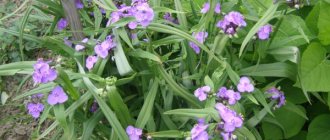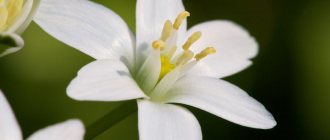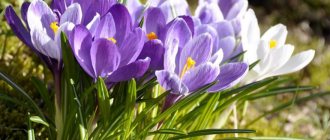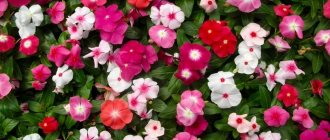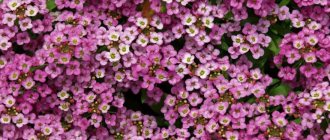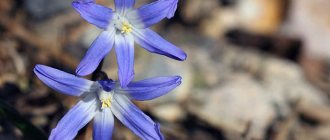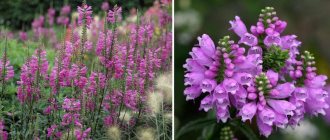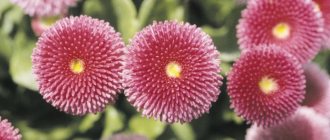Author: Elena N. https://floristics.info/ru/index.php?option=com_contact&view=contact&id=19 Category: Garden plants Published: June 18, 2018Last edits: November 04, 2020
- Growing conditions
- American Erythronium (Erythronium americanum = Erythronium angustatum = Erythronium bracteatum)
- Beneficial features
Kandyk, or erythronium (lat. Erythronium) is a genus of herbaceous perennials of the Liliaceae family, representatives of which grow naturally in the mountain forests of North America, Europe, Southern Siberia, Manchuria and Japan. Mention of this early spring ephemeroid can be found in the writings of Dioscorides. The Latin name for the genus was given by Carl Linnaeus, and it is derived from the Greek name of one of the species. And the word “kandyk” is of Turkic origin and is translated as “dog tooth.” Some species of erythronium (Caucasian, Japanese and Siberian kandyki) are considered endangered and are listed in the Red Book. In total, there are 29 species in the genus, and some of them are grown as cultivated plants.
Planting and caring for erythronium
- Flowering: for 2-3 weeks in April or May.
- Planting: both sowing seeds and planting bulbs in the ground occurs at the end of summer.
- Lighting: Kandyks that bloom in early April are grown in partial shade, and those that bloom in late April are grown in bright sun.
- Soil: light, moist, peaty and slightly acidic.
- Watering: only in May, if the spring is dry.
- Top dressing: it is enough to mulch the area with peat or leaf humus, but you can also apply mineral fertilizers once a season.
- Reproduction: seeds and children.
- Pests: mole crickets, moles and mice.
- Diseases: practically not affected.
- Properties: the plant is one of the best honey plants. Kandyk honey has healing properties.
Read more about growing erythronium below.
Several varieties
Based on the culture, up to 20 varieties were bred. Among the most common are the following:
- White Tsar (Alba regem). The variety is considered early. The flowering period lasts from mid to late April. The central part of the white flowers is colored lemon. The surface of the flower petals is decorated with small red dots. At the end of flowering they take the form of a turban. The leaves of this variety are bright green.
- White fang. The plant blooms from April 20 to April 30. Its white flowers have a yellow center. The surface of the flower petals is covered with yellow dots. The length of the peduncle reaches 6 cm. The leaves and peduncle are dark green.
- Olga (Olga). This variety blooms until mid-May. The flowers are lilac-orange with a white border. Brown-green leaf blades are decorated with a white border.
Botanical description
Kandyki reach a height of 10-30, rarely 60 cm. Their bulbs are annual, ovoid-cylindrical in shape. A pair of opposite, petiolate, elongated lanceolate leaves, sometimes solid green, but often mottled with brown spots, is located at the base of the peduncle, on which a flower is formed with a large, drooping perianth, consisting of 6 yellow, white or pinkish-purple leaves. Sometimes there may be several flowers on an arrow. Flowering begins in late April or early May. The fruit of erythronium is an egg-shaped capsule with a small number of seeds.
Features of kandyk
The kandyk plant most often has a height of 0.1 to 0.3 m, in rare cases it can reach 0.6 m. The shape of the annual bulbs is ovoid-cylindrical. At the base of the peduncle there are two petiole oppositely located leaf plates, the shape of which is elongated-lanceolate; most often on their surface there is a large number of brown spots, but there are also solid green ones. At the top of the peduncle grows a flower with a drooping large perianth; it contains 6 leaves of white, yellow or purple-pink color. In some cases, several flowers grow on the arrow. Kandyk blooms in the last days of April or the first days of May. The fruit is an ovoid capsule containing a few seeds.
KANDYK (School of Herbal Science)
Planting erythronium in open ground
When to plant
Kandyki, which bloom in early April, are best grown in partial shade on the north side of the garden, under the lacy crowns of trees and bushes. Since flowering of erythronium begins even before leaves appear on trees and shrubs, there will be enough light for the plant at the beginning of active growth. Erythronium species that bloom at the end of April are best planted in an area well lit by the sun. In this way you will slightly delay the onset of flowering of early species of erythronium and at the same time speed up the appearance of flowers in later species.
In the photo: Growing erythronium in the garden
Kandyk prefers soils that are light, peaty, acidic and moist, with approximately the following composition: coarse sand, leaf soil and humus. A couple of weeks before planting, 100 g of crushed chalk, 200 g of bone meal, 150 g of superphosphate and 30 g of potassium nitrate are added to each m² of plot.
- Reproduction of boxwood in the fall - how to properly separate a cutting and where to plant it so that it takes root successfully
How to grow hazel grouse - secrets of success
Erythronium is propagated by both seeds and offspring. All American species, with the exception of the multi-stemmed candyk, are propagated only by seeds, which are collected in June.
It is important not to miss the moment when the ripe boxes begin to open, because the seeds will simply fall to the ground and will be carried away by ants or pecked by birds.
It is better to remove the boxes a little earlier and ripen the seed in a dry room with good ventilation.
Both sowing seeds and planting erythronium bulbs in the ground are done at the end of summer.
How to plant
Ripe erythronium seeds are placed at a distance of 5 cm from each other in grooves 3 cm deep, located at a distance of 10 cm from each other, after which the grooves are sealed and watered. For the winter, the area with crops is covered only if there is a very cold winter ahead without snow. The shoots will appear in the spring, and by the end of April they should reach a height of at least 4 cm. If the shoots are lower by this time, it means that the erythronium lacks moisture or nutrition.
During the first season, plants form bulbs measuring about 4 mm, during the second season the bulbs grow up to 7 mm, and during the third they acquire a cylindrical shape, are buried independently in the soil by 7-10 cm and increase in diameter to 8 mm. Plants grown from seeds bloom in the fourth or fifth year after germination. If you decide to sow erythronium in the spring, then the seeds must first be stratified for 2-3 months in the vegetable drawer of the refrigerator, placing them in a plastic bag with wet sand or peat.
If you grow erythronium from bulbs, then each species has its own requirements for this procedure: European-Asian varieties are immersed 10-15 cm, maintaining a distance of at least 15 cm between the bulbs, and American species are buried 16-20 cm, keeping between them of the same interval. After planting, the area is mulched and watered.
Planting with bulbs
The depth of planting of bulbs depends on their size. European-Asian erythroniums are buried at 10-15 cm, American ones at 16-20 cm. The distance between bushes is maintained at 15 cm.
Important! Bulbs need high humidity. Left without shelter, they quickly dry out and die. Moistened sphagnum moss is suitable for storage. You can use a box with sand and peat.
Reproduction by baby bulbs
Unlike full-fledged adult specimens, children will produce their first buds with a delay of 1 year. They are usually planted at the end of June. 3-4 pieces are lowered into the holes.
Caring for erythronium in the garden
Growing conditions
Planting and caring for erythronium is simple and not labor-intensive. The plant almost does not need watering, and if the area is mulched, then loosening and removing weeds will also be necessary infrequently.
Watering and fertilizing
In early spring, when the active growth of kandyk begins, the soil is usually saturated with melt water, so the plant may need moisture only in May and if the spring turns out to be dry.
From time to time, after rain or watering, you should lightly loosen the soil around the plants and remove weed seedlings.
As for fertilizing, for the first season the plant will have enough fertilizer applied to the soil during planting or sowing, and then simply mulch the area with organic material - peat or leaf humus. Erythronium also responds well to mineral fertilizers for ornamental flowering plants.
In the photo: Growing kandyk in the ground
Transplantation and propagation
Once every 4-5 years, you should dig up and replant kandyk bulbs that have turned into nests over such a period of time. Simultaneously with the transplantation, erythronium is propagated by dividing the bulb. It is better to do this in the second half of summer, in July or even in August, when the plants are dormant. By this time, the erythronium foliage should have already turned yellow, and the bulbs should have regained their strength after flowering.
The children are separated from the dug up bulbs and, having treated the fracture sites with coal powder, the planting material is quickly planted in the furrows prepared in advance in the manner described earlier. It is impossible to keep the bulbs in the air for a long time, since they do not have covering scales and immediately begin to dry. If there is a need to store planting material, then place the bulbs in a box with damp sand, sphagnum or peat.
- What preparations do we necessarily use to treat seedlings to prevent diseases?
We already told you how to propagate erythronium by seed at the beginning of the article.
Erythronium in winter
The cold resistance of erythronium allows it to spend the winter in open ground, however, in very severe frosts or snowless winters, the area must be covered with a thick layer of dry leaves or spruce branches. Remove the cover in early spring, when the snow melts.
Benefit
Lilac: description, types and varieties, planting in open ground and caring for ornamental shrubs (85 photos & videos) + reviews
If the kandyk honey is real, then it will bring invaluable benefits. The authenticity of honey can be recognized in this way: it will not be cheap, it should have a spicy aftertaste, have the smell of wax and the color of baked milk with grains when candied. The original color of the product is darker.
The most beneficial feature of this product is that it can restore liver cells. Kandyk honey is recommended for use by people who have pancreatitis, gastrointestinal diseases, colds, and metabolic disorders. There are anti-inflammatory and antimicrobial properties.
If heat treatment is carried out, then the healing properties of honey will decrease. It must be consumed systematically in its pure form, but in a certain dose. If you eat one dessert spoon every morning on an empty stomach, then digestion will begin to work well.
And if you take 1 spoon at night, insomnia may go away. To rejuvenate and tidy up the sebaceous glands of the skin, you need to use a lotion containing 1 liter of water and half a glass of honey.
You should not consume honey in large quantities. You can eat no more than 100 grams per day. Another contraindication to consumption is its individual intolerance.
Pests and diseases
Erythronium is resistant to diseases, and its main enemies are mole crickets and rodents - moles and mice. To avoid the death of all erythroniums, it is advisable to plant them in different places in the garden. In pest control, traps are used: for mice and moles - baits with poison, and for mole crickets, holes are dug and fresh manure is placed there, into which insects will certainly crawl to lay eggs. Traps for mole crickets are covered with pieces of board or slate, and when a decent number of pests have collected in them, you can begin to destroy them.
How to distinguish kandyk honey?
It is difficult to purchase medicinal kandyk honey; experienced people recommend looking for it only in Siberia or Altai. In other places it is easy to buy a fake, since the freshly harvested product is very similar to buckwheat, which is what unscrupulous sellers take advantage of
But the price of kandyk is several times higher, so it is important to be able to distinguish the natural mixture
The only sign that allows us to distinguish it from buckwheat is that in the light the kandyk acquires a bright shade. And by mid-autumn it becomes light, so if a dark-colored product is offered at this time, it is a fake. You can also buy cream honey without fear of counterfeits; it looks like a paste the color of baked milk and is always packaged by hand, which is also a distinctive feature.
There are some other criteria for distinguishing real honey from fake:
- After thickening, the kandyk acquires a milky hue, but, depending on the place and time of collection, the color can vary from light to purple.
- The structure becomes granular, inclusions appear in it, similar to drops of baked milk.
- Honey retains a rich floral aroma.
- Fresh kandyk honey has a thick and viscous consistency, and when it crystallizes, it looks like oil. If the knife enters the mixture like butter, then it is natural honey.
- Honey crystals hold their shape well and are felt on the tongue.
- If you try honey from kandyk, first a cloying sweetness appears, and then a bitterness with tart notes appears.
Types and varieties of kandyk
Some types of erythronium are more popular in cultivation than others, and we will introduce you to the most commonly found plants of this genus in gardens.
American Erythronium (Erythronium americanum = Erythronium angustatum = Erythronium bracteatum)
It grows in the subtropical and warm-temperate zones of the central and eastern regions of Canada and the United States of America, rising in the mountains to heights of up to 1500 m above sea level. It has an ovoid bulb, oblong or lanceolate leaves covered with brown spots up to 20 cm long and up to 5 cm wide and a peduncle up to 30 cm high. The tepals of this species are painted bright yellow, sometimes with a purple tint.
In the photo: American Erythronium (Erythronium americanum = Erythronium angustatum = Erythronium bracteatum)
Erythronium albidum
It grows in the central regions of the USA and Canada and resembles Erythronium americana. The tepals of this species do not have lobes at the base and may be white or tinted pink, blue or purple.
In the photo: Erythronium albidum
Erythronium multiscapoideum = Erythronium hartwegii
Grows on damp rocks and light forests in the warm temperate and subtropical zones of the southwestern United States. It has an ovoid oblong bulb, at the base of which stolons are formed. The oblanceolate leaves are mottled and the creamy yellow flowers with an orange base that turns pink when withered are borne on long stalks. There can be from 1 to 3 flowers on one peduncle.
In the photo: Erythronium multiscapoideum = Erythronium hartwegii
Erythronium hendersonii
Native to the dry meadows and light forests of Oregon, it was introduced to Europe in 1887. It has an oblong bulb on a short rhizome, leaves with dark brown spots and a stem 10 to 30 cm high, on which 1 to 3 light purple flowers are formed with an almost black base and purple stamens with light brown anthers.
In the photo: Erythronium hendersonii
Mountain Erythronium (Erythronium montanum)
Grows in alpine meadows of the northwestern United States. It has a narrow, oblong bulb, a stem up to 45 cm high, oblong-ovate leaves on winged petioles, sharply narrowed towards the base. The arrow may have one or more white or pinkish flowers with an orange base of bract leaves.
In the photo: Mountain Erythronium (Erythronium montanum)
Lemon yellow candyk (Erythronium citrinum)
Grows in montane forests in the warm temperate climate of the Western United States. It has blunt, spotted broadly lanceolate and short-petioled leaves with a short sharp apex and a stem 10-20 cm high, on which there can be from 1 to 9 lemon-yellow flowers with strongly reflexed tepals, the bases of which are colored orange, and the tips to the end the blooms take on a pink tint.
In the photo: Lemon yellow Kandyk (Erythronium citrinum)
Erythronium californicum
Can be found in light forests of California. It has blunt, oblong, spotted leaves up to 10 cm long on a winged petiole and a stem up to 35 cm high with one or more flowers. The creamy white tepals have an orange base. The plant has a garden form with two-color - creamy yellow and white - flowers. The most popular hybrids of the species are:
- White Beauty is a plant with large snow-white flowers with a dark brown ring in the middle. The tepals curl up to form a Chinese pagoda shape;
- Harvington Snowgoose is a variety with large flowers with cream tepals, lemon yellow at the base.
In the photo: Erythronium californicum
Large Kandyk (Erythronium grandiflorum)
grows in forests and on mountain slopes in the steppe regions of Canada and the USA. Its bulb is located on a short rhizome, the stem reaches a height of 30 to 60 cm, and solid green oblong-lanceolate leaves up to 20 cm long smoothly turn into a short petiole. From one to six flowers can form on the stem with golden-yellow tepals with a lighter base. The species has several varieties and varieties:
- large-flowered white - kandyk with snow-white flowers;
- large-flowered golden - a plant with yellow anthers;
- large-flowered Nuttalla - kandyk with red anthers;
- large-flowered pale - a variety with white anthers;
- Biyanka - a variety with white flowers;
- Rubens - kandyk with red-pink flowers.
In the photo: Large Kandyk (Erythronium grandiflorum)
Erythronium oregonum
or Erythronium revolutum is distributed in the nemoral region and subtropical zone of the Pacific coast of the United States of America and Canada . The stem of this plant is from 10 to 40 cm high, the leaves are oblong-lanceolate, tapering to the petioles, and spotted. The tightly curled, creamy white tepals turn yellow at the base and turn purple towards the end of flowering. The anthers of the flowers are white. This species is more moisture-loving than others and has several popular forms:
- inverted white-flowered - a variety with white flowers with a slightly greenish tint and a brown base of the perianth leaves;
- Johnson's wrapped - a form with dark pink flowers and shiny green leaves with brown spots;
- wrapped early is a variety with creamy white flowers with an orange base and green leaves spotted with mahogany.
In the photo: Erythronium oregonum
Erythronium tuolumnense
grows in the foothills of the Sierra Nevada. This kandyk reaches a height of 30-40 cm. It has single-colored green lanceolate or oblanceolate leaves up to 30 cm long, located on the stem on long petioles. The stem also bears one or more golden-yellow flowers with a greenish-yellow base. The most famous varieties:
- How to plant and care for floribunda roses
- Pagoda is a variety with lemon-yellow flowers;
- Congo is a hybrid of Tuolumnia and avertum with sulfur-yellow flowers, a brown ring on the inside of the perianth and reddish-brown veins on the leaves.
In the photo: Erythronium tuolumnense
Siberian Erythronium (Erythronium sibiricum = Erythronium dens-canis var. sibiricum)
native to Mongolia and Southern Siberia, where it grows along the edges of mixed and coniferous forests of the Sayan and Altai. This species has a very fragile white ovoid-cylindrical bulb, the shape and color of a dog's fang, and a stem 12 to 35 cm high with two opposite green leaves, elliptical and pointed at the apex, covered with a red-brown marbled pattern. At the end of the stem, a drooping flower with a diameter of up to 8 cm is formed with lilac-pink or white tepals bent to the sides. The base of the leaves is light yellow with small dark specks. The anthers of the flower are golden yellow, the pistil is white. There are varieties with almost brown or brown leaves with a narrow green border, but over time the pattern on the foliage disappears.
In the photo: Siberian Erythronium (Erythronium sibiricum = Erythronium dens-canis var. sibiricum)
Erythronium caucasicum
is endemic to Western Transcaucasia, where it grows in mountain forests. It has an ovate-cylindrical or oblong bulb, a stem up to 25 cm high and bluish, spotted ovate-oblong leaves on stem-encompassing petioles. The white or light yellow tepals at the base are orange-purple on the outside and yellowish on the inside. This species is not cold-resistant and requires shelter for the winter.
In the photo: Caucasian Erythronium (Erythronium caucasicum)
European Erythronium (Erythronium dens-canis)
or dog's tooth (Erythronium maculatum) grows in deciduous mountain forests and shrubs in the subtropics and warm-temperate zones of Europe, including in the western regions of Ukraine, and in the Alps it rises to a height of up to 1700 meters above sea level. Its bulb also resembles a dog’s fang in shape and color, the pinkish stem reaches a height of 10 to 30 cm, and the broadly lanceolate green leaves tapered to a grooved petiole, located at the base of the stem, are covered with purple spots. A single drooping flower with lanceolate, pointed, pink or purple, rarely white tepals, bent back, blooms on the stem. The short stamens of the flower have bluish, almost black anthers. This highly decorative winter-hardy species has been in cultivation since 1570. Erythronium europaea has a variety with snow-white flowers (var. niveum) and a long-leaved form with larger flowers than the main species and long pointed leaves (var. longifolium). The most popular varieties are:
- Charmer is a variation bred by Thunbergen in 1960 with a large brown spot at the base of the flowers. The perianth is lavender in color. Leaves have brown markings;
- Frans Halls - the perianth of this variety is uniformly purple on the outside, and decorated with bronze-green spots on the inside. The middle of the flower is yellowish-green;
- Lilac Wonder - this cultivar has purple flowers with a chocolate-colored ring at the base of the perianth leaves on the inside and a brown ring on the outside;
- Pink Perfection is an early flowering variety with a bright pink perianth;
- Snowflake - garden form with snow-white flowers;
- Rose Queen is a rare and very beautiful variety with pink flowers;
- White Splendor is a variety bred by Tubergen in 1961 with white flowers with a red-brown spot at the base of the perianth leaves.
In the photo: European Erythronium (Erythronium dens-canis)
Japanese Erythronium (Erythronium japonicum)
grows on Sakhalin, the Kuril Islands, Japan and Korea. The species is highly decorative. Its bulb is cylindrical, lanceolate, the stem is up to 30 cm high, the leaves are petiolate, oblong, narrow, up to 12 cm long. One drooping pink-purple flower is formed on the stem.
In the photo: Japanese Erythronium (Erythronium japonicum)
Erythronium hybridum
combines varieties formed by crossing different species and varieties of erythronium. The best ones:
- White Tsar is a plant with snow-white flowers with a lemon center and a barely noticeable dotted border of a reddish hue. Leaves are bright green;
- Scarlet is a variety with bright crimson flowers with a white ring, inside of which there is a ring of crimson dots. The center of the flower is yellowish, the leaves are brown with green dots, and green at the ends;
- White fang - kandyk with white flowers up to 6 cm in diameter with a yellowish center and green leaves and peduncle:
- Harmony - flowers up to 8 cm in diameter: the leaves are pink at the ends and white closer to the base, the center is light yellow in color and edged with red dots. Young green leaves are covered with a brown pattern, but this disappears with age;
- Olga is a variety with lilac-pink flowers with dark pink dots and a white edging at the ends of the lobes. The leaves are brownish-green with a green stripe along the edge.
What is a kandyk?
The amazing kandyk plant is an original, spring bulbous crop. Dogtooth belongs to the Liliaceae family. The Greek name is “Erythronium”, meaning “red”, this color was the first flowers found by plant growers. There are 25 varieties of culture.
Description of inflorescences
The buds are similar to lilies or cyclomena; there are 1-2 flowers on 1 peduncle. The corolla contains 6 elongated stems, gracefully bent petals 15-20 mm long. They are colored yellowish, crimson, pinkish and white.
Appearance of bushes
The bushes grow up to 50 cm in height, the leaves are decorative. Leaves of an oblong shape, green in color with brown spots, extend from the base of the shoot. Depending on weather conditions, pollen falls in late April or early May. The fruit includes a seed box.
Places of growth
Under natural conditions, the kandyk “lives” in the mountains of Western Europe. The flower prefers cool, open, bright areas in the temperate or subtropical zone. Many people like the culture due to its unpretentiousness and high resistance to frosts down to -50. Erythronium harmonizes with other bulbous plants.
Properties of kandyk - harm and benefit
Beneficial features
Kandyk is an excellent honey plant. Its nectar contains fructose, glucose, minerals, enzymes, acids, vitamin E and other substances beneficial to the human body. Kandyk honey has a delicate aroma and valuable healing properties, since it contains not only vitamins and enzymes, but also emollients. Kandyk honey is used to treat cough, fever, and reduce temperature. Honey is used in cosmetology to produce antiseptic honey water that does not dry out the skin.
Erythronium bulbs, which contain antispasmodics and higher alcohols, are also widely used in folk medicine. Fresh kandyk bulbs are a remedy for preventing seizures, including epilepsy.
Kondak leaves have a general strengthening effect, prevent the aging process and are used to prevent impotence in men. In addition, they are rich in enzymes, dietary fiber, minerals and vitamins. The leaves are eaten fresh and pickled. And rinse your hair with a decoction of kandyka herb to strengthen the hair follicles.
Contraindications
Erythronium pollen can cause hay fever in people predisposed to allergic reactions: if after a walk in the garden where erythroniums grow, you suddenly develop a runny nose, swollen sinuses, or a rash, consult a doctor immediately.
Problems can also arise if you overeat kandyk honey: this product increases appetite and blood sugar levels. Erythronium honey is contraindicated for diabetics and people sensitive to glucose.
Eating honey or parts of kandyk can lead to hypervitaminosis, especially if you simultaneously take pharmacy multivitamins or dietary supplements containing vitamins. Even if you are absolutely healthy and are planning to take kandyk as a general tonic, consult a doctor first.
Plant varieties
In specialized nurseries these days you can purchase a rare decorative or honey-bearing species. The acquired bulb should not have any damage with traces of fungal infection.
At the moment, 25 species of Kandyk have been studied. But in our country only 3 species grow - these are Siberian Kandyk, Caucasian Kandyk, Japanese Kandyk. North America has a wide variety of species, with the most common plant there being the California Kandyk.
Caucasian Kandyk
A unique representative of the variety. The petals are white, sometimes light yellow. The size of the plant is small - 0.1-0.25 meters, but the petals in the bud are 40 millimeters in length. The leaf plates do not have petioles in comparison with other species; they are attached to the stem and fit it tightly. There are purple spots on the outside of the leaf, which has an elongated ovoid shape.
Siberian Kandyk
It is located on the slopes of mountains in Altai and Sayan Mountains, in the southern part of Siberia and Mongolia. Ten varieties were bred based on this species due to its polymorphism. There are varieties reaching a height of 0.12-0.35 meters. The cylindrical root is 80 millimeters long. Brown spots cover the green leaf blades. There are plants whose leaves are 0.15 meters long and 60 millimeters wide. The flower has a drooping appearance with a diameter of 50-80 millimeters, and can be white, pink or purple.
European Kandyk
It is the basis for new varieties - American and Dutch varieties. The stem is pink. The height of the European Kandyk is 0.1-0.3 meters. The leaf blades are wide, lanceolate-shaped with purple spots. The rhizome is white, cylindrical in shape, with small appendages. Because of the peculiar shape of the root, kandyk is popularly called a dog's tooth. The flowering period lasts two to three weeks. The flowers are purple or pink. The petals are strongly curved with a length of 20-40 millimeters.
Japanese kandeuk
Distributed in Japan, the Kuril and Sakhalin Islands, and Korea. This erythronium is quite large with a height of 0.3 meters. The flowers are also large, reaching 80 millimeters in diameter. When the plant blooms, the color of the buds changes, first bright pink, and then light pink. There are purple spots near the base of the bud - this is the main feature. A spherical capsule is formed when flowering ends. Onion - 60 millimeters. The length of the leaves reaches 60-120 millimeters, and the width is 25-50 millimeters. By mid-summer the plant dies completely, however, like all varieties.
Use in landscape design
With its grace, this perennial has won the hearts of many landscape designers. The flower is suitable not only for single plantings, but also forms a good tandem with other bulbous plants. In particular, it will harmoniously combine with crocuses, tulips, daisies, lilies, liverwort, chiondoxa, Caucasian arabis, and brandushka. Also, kandyk looks advantageous against the background of low shrubs: juniper, cotoneaster, holly mahonia.
Its only drawback is the loss of decorative appearance and complete death after spring flowering. Therefore, plants with lush foliage should be planted nearby in order to cover the future empty space.
Erythroniums are distinguished by their amazing beauty and originality. More recently, they were more common in Europe, but now they are being bred more and more in our country. They look great in rock gardens, rocky gardens, on lawns, against the backdrop of shrubs and trees.
How does a flower reproduce?
Kandyk is bred with seeds or babies. In the first case, all American varieties can be propagated, except for the multi-stalked erythronium. Seed collection begins in June, but only after the capsules are fully formed. Their contents should be on the surface of the plot.
According to experienced gardeners, slightly unripe specimens are cut off and then placed for ripening in a ventilated place with low humidity. Sow seeds or bulbs in the last days of summer.
Source
When planning a landscape design, you want to diversify the area as much as possible with different plants. Experienced gardeners also take into account the flowering time of flora representatives in order to make their plantation bright and blooming throughout the spring-summer-autumn period. Erythronium pagoda is a plant that blooms in early spring with an original unusual color. That is why many summer residents choose it to decorate their site with the onset of the new season. In this article we will describe in detail the features of erythronium cultivation and tell you how to properly plant and care for this plant.
Kandyk Caucasian. Red Book
Kandyk Caucasian
Caucasian Kandyk Erythronium caucasicum Woronow Category and status: 3 d - rare species. Endemic to the Western Caucasus and Transcaucasia (with an enclave on the Stavropol Upland). A brief description of. Early spring bulbous ephemeroid. The stem is 10-20 cm high, with 2 opposite lanceolate oblong, bluish, red-spotted leaves. Blooms in the 5th year. Blooms in March-April. Fruits in April-May. It reproduces mainly by seeds, which are carried by ants. The bulb is renewed annually. Spreading. The species in Russia is found in the Krasnodar region: from Novorossiysk, Goryachiy Klyuch to the eastern border of the region, especially often within the Caucasus Nature Reserve, everywhere on the ridges in the Krasnaya Polyana region (the cities of Achishkho, Pseashkho, Assara, Aibga, etc.); in the Republics of Adygea (Abadzekhskaya station, Enem village, Fishta, Oshten, Chugush mountains) (1-3), Karachay-Cherkessia (upper reaches of the Kuban) (4); in the Stavropol Territory (in the vicinity of Stavropol: Taman Forest, Russian Forest) (5). Described from the city of Aibga. Outside Russia it grows in Georgia, Northwestern Iran (b, 7). Features of ecology and phytocenology. It grows from the lower mountain to the alpine belt, on the edges and clearings in deciduous and mixed forests, in meadows near melting snow. Number. More than 500 thousand individuals. State of local populations. In some places it occurs abundantly, sometimes creating an aspect. In the highlands it is preserved better, since it has time to bloom by the beginning of the tourist season. In the Taman forest near the city of Stavropol, the population was destroyed (8). Limiting factors. Harvesting for bouquets and digging up bulbs for transfer to gardens and commercial purposes. Deforestation, recreation. Ornamental plant. The bulbs are used in folk medicine. Security measures taken. It was included in the Red Books of the USSR (1978,1984) and the RSFSR (1988). The species is included in the Red Books of the Krasnodar Territory (1994, 2007), Sochi (2002), Stavropol Territory (2002), the Republics of Karachay-Cherkess (1988) and Adygea (2000). Found on the territory of the Caucasian Biosphere Reserve and Sochi NP. Necessary security measures. Prohibition of plant collection. Monitoring the state of populations. Cultivation possibilities. Cultivated in the botanical gardens of Stavropol (8, 9), St. Petersburg (BIN RAS), Moscow (GBS RAS, Moscow State University), Sochi (Subtropical Garden of Kuban), Pyatigorsk (BIN RAS station) (12). Information sources. 1. Altukhov, Mordak, 1988; 2. Altukhov, Litvinskaya, 1986; 3. Solodko, Kiriy, 2002; 4. Vorobyova, 1988; 5. Tanfilyev et al., 1976; 6. Grossheim, 1940; 7. Wendelbo, 1977; 8. Red Book of the Stavropol Territory, 2002; 9. Shevchenko, 2002; 10. Plants of the Red Book..., 2002. Compiled by: A.D. Mikheev.
Care
Since erythronium is unpretentious, no special care is required after planting. The soil should be periodically loosened and weeds removed. From time to time, you can fertilize the soil with fertilizers so that the flower grows faster.
After several years (from five to seven), the bulbs must be transplanted to another place (separating the daughter ones).
When replanting, it should be taken into account that there is no protective layer on the bulbs. For this reason, they cannot stay outdoors for more than a day. After lying in the sun for only a few hours, the bulbs dry out and lose their growth properties. You can keep them for three weeks if you place them in moss or damp sawdust.
Additional spraying from a spray bottle is not required, since the air humidity should not be too high. Otherwise, Erythronium can easily get sick. If grown in a region with high humidity, you may have to constantly fight fungal diseases.
During the growing season of the plant, moderate watering is recommended; in the future, it can be watered to a minimum. The water should always be clean.
Depending on the specific type, the minimum and maximum temperatures that it can withstand vary. In general, the perennial is frost-resistant. The Siberian kandyk will not freeze, even if the thermometer drops below 50 degrees.
Japanese erythroniums do not tolerate hot summers. Caucasian species, on the contrary, tolerate heat very well.
Most varieties do not like sudden changes in temperature. For the winter period, it is better to insulate some of them.
Meaning and Use
Bulbs of some species are used as food and medicine.
Kandyk species are often grown in gardens as an early spring ornamental plant, as well as in rock gardens.
According to S.I. Rostovtsev, “bulbs are used by the Tatars for food; an intoxicating drink called abyrtka
, replacing beer at Tatar holidays. Previously, the tubers (lat. Radix dens canis) were used in medicine for worms, colic, epilepsy and as an aphrodisiac.”
Agricultural technology of cultivated plants
S.I. Rostovtsev wrote: “The land should be sandy, or better yet, heather or forest. Loves shade. It reproduces best by children from bulbs. They are separated every 3 years after fruiting. They winter without a tire even in St. Petersburg.”
Varieties
According to the Royal General Bulb Growers' Association (KAVB) for 2011, 15 varieties are registered:
- E. dens-canis
'
Anna Carolina'
. The flowers are purple. - E. dens-canis
'
Charmer'
. Registrar: Tubergen. The flowers are white, the base of the flowers is brown and lilac, the inside is lavender with a brown ring, and the center is greenish. The leaves are brownish with irregular streaks. Awards: TGA-BC 1960. - ' Citronella'
W.P. van Eeden, 1992. - E. dens-canis
'
Frans Hals'
. The flowers are purple with a greenish-bronze base and greenish-yellow in the center. - ' Jeanette Brickell'
E.C. Anderson, 1978. Slightly variegated leaves. The flowers are white, up to 7 pcs. A variety of hybrid origin, created in 1956, registered in 1978. - ' Jeannine'
. Recorder: WP van Eeden, 1984. Plant height 30-40 cm. Flowers sulfur-yellow. Awards: AM-BC 1984. - ' Kondo'
. Recorder: L. Slikker. The flowers are sulfur-yellow, the center of the ring is brown; it differs from the variety 'Pagoda' in the variegated leaves. Awards: AM-BC 1960, TGA-BC 1963, FCC-BC 1962. - E. dens-canis
'
Lilac Wonder'
. Registrar: N. Roozen. The flowers are purple with a brown base. Awards: AM-BC 1943. - ' Pagoda'
. Originator: L. Slikker, Registrar: Walter Blom & Sons. Plant height is 20-30 cm. The flowers are yellow, with a brown center. Awards: AM-BC 1959, FCC-BC 1963, TGA-BC 1963. - E. revolutum
'
Pink Beauty'
. The flowers are pale pink. - E. dens-canis
'
Pink Perfection'
. The flowers are pink. - E. dens-canis
'
Purple King'
. Recorder: GC van Meeuwen, 1937. The flowers are purple-violet, with brown spots and stripes edged in white in the center. Awards: TGA-BC 1960. - ' Rippling Waters'
. Registrar: ICRA, 2008. Leaves with a well-defined marbled pattern. The flowers are white, up to 8 cm in diameter. The throat and anthers are yellow, the filaments are expanded at the base. - E. revolutum
'
Rose Beauty'
. Leaves with dark brown streaks, pink flowers. - E. dens-canis
'
Rose Queen'
. The flowers are pink.
Erythronium kandyk pagoda: description of the plant
Erythronium pagoda or kandyk is a perennial plant of the lily family. It blooms in early spring and has drooping flowers reminiscent of lilies or cyclomena. There are different colors, the most common colors are:
- yellow;
- purple;
- white;
- pink.
The height of the kandyk can reach up to 47 centimeters. The foliage is quite decorative. In nature, the plant is often found in the mountains of Western Europe. In general, it grows in cool, open, light areas in the temperate or subtropical zone.
Many gardeners fell in love with kandyk for its unpretentiousness; moreover, the plant is highly frost-resistant and decoratively compatible with other bulbous flowers.
Reproduction
There are 2 main methods by which the Siberian kandyk can be propagated:
- Seeds . This option is used very rarely, which is due to the low rate of seed germination. It is recommended to use freshly collected seed. Seeds are sown in the ground at the end of summer. Before planting, the bed is dug up. In this case, garden soil, sand, humus and peat should be added to the soil. The sowing depth of Siberian kandyk seeds is not less than 3 cm. Upon completion of sowing the seed material, the bed must be mulched and watered. The first shoots in this case will appear in early spring.
- Bulbs . This propagation method can be used for plants that are over 5 years old. In this case, the daughter bulbs are separated from the mother bulb. To prevent the development of the rotting process, the bulbs need to be treated with crushed activated carbon. With this propagation method, flowering occurs in the next season.
You can increase the germination rate of young plants by using the second propagation method.
Conditions for growing indoor kandyk
This bulbous plant is not quite like its garden counterparts. In rooms, the kandyk will need brighter lighting and more restrained temperatures. But otherwise, growing kandyk is not at all difficult. Due to the fact that the cool period of preparation for flowering coincides with the end of autumn and the beginning of winter, creating a suitable environment for the bulbous plant is not difficult.
Lighting and placement
Despite the status of a shade-loving primrose, kandyks need completely different conditions in rooms than in the garden. Here it is better to replace shadow or partial shade with good, but diffuse lighting.
Containers with planted kandyk bulbs are kept in shade before being transferred to heat and light. From August-September to December, for 3-4 months, they should be in the shade. During the period of active growth and flowering, light, protected from direct rays, but not semi-shaded locations are selected for kandyk. This bulbous plant blooms best on windowsills or near windows.
For kandyk, windows of eastern and western orientation are preferable. Touching plants can be used as accents in seasonal interiors and small living bouquets.
Temperature and ventilation
For kandyk there is no need to observe a very strict alternation of warm and cold periods in order to achieve flowering. After planting the plant, the kandyk is kept at normal temperatures for 6-8 weeks for rooting, and then transferred to any frost-free cool room (with a temperature from 2 to 12 degrees).
At the cool stage, the plant is kept until December, after which it is transferred to any living room with an air temperature of more than 18 degrees. Regular room temperatures are quite suitable for kandykas, but the more moderate the temperatures, the longer the flowers of this plant will last.
Siberian Kandyk (Erythronium sibiricum). © zastavkin
